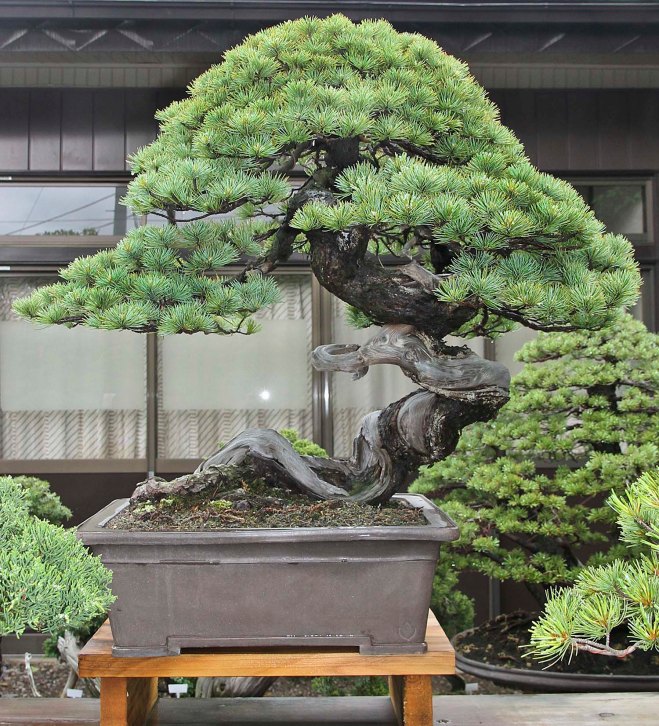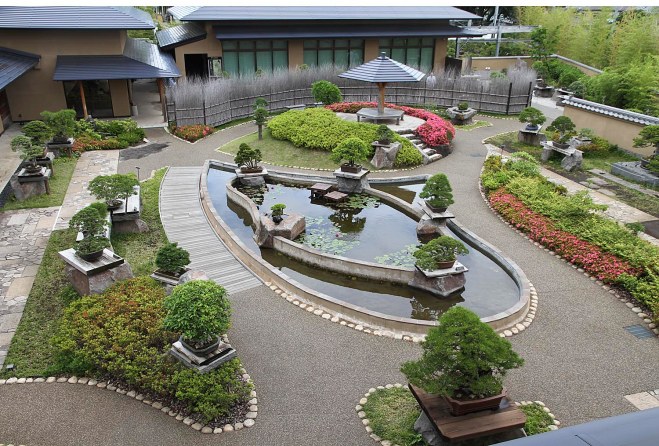MASAHIKO KIMURA
Saitama City
Our first stop today was at the private garden of Masahiko Kimura where we saw magnificent, mostly large size bonsai. Nearly every tree was an evergreen, many with dead wood, but not all. Three were numerous famous masterpieces as well as Important Bonsai Masterpieces and award winning trees from the Kokufu Bonsai Exhibition.
Mr. Kimura was a gracious host and all of group were served tea and Japanese cookies. Of interest to most of our members was not a large size tree, nor evergreen, but rather a small tropical tree. A few knew the name was “Yesterday, Today and Tomorrow” but could not think of the botanical name. So, I took out my iPhone and searched and discovered the name is Brunfelsia pauciflora, a small plant native to Brazil. I’ve seen it in Florida and it’s beautiful with purple, white and pink flowers on the plant at the same time.
As we were studying the bonsai Joe Noga saw something unusual. There were a couple of common looking Shimpaku junipers being grafted at the bottom of a famous, award winning larger Shimpaku juniper. I could not think of the reason because the tree had some roots and lots of dead wood on the bottom of the trunk. So, I found Mr. Kimura and he explained he wants to shorten the tree and grafting new roots so he can successfully remove the lower trunk and original root system.
Throughout the display area, if one looks closely, you can see numerous approach grafts to add branches or change the variety of juniper. There was one tree where the small potted plants were visible so it was photographed. This approach grafting technique to change the variety is quite common in Japan. Most of the collected Champak junipers have coarse foliage and a finer textured cultivar is grafted to completely change the variety of the bonsai. Many of the famous Shimpaku juniper bonsai in Japan have been grafted to improve the foliage which is not widely known.
OMIYA BONSAI ART MUSEUM
Omiya
Hydrangea
Next we visited the Omiya Bonsai Art Museum where we saw excellent educational displays indoors accompanied with beautiful bonsai. The three different styles of alcove display were demonstrated with masterpiece bonsai, all coordinated with the late spring season.
The exhibition gallery building was of most interest to me because of the display on The Story of “Bonsai”– The History of Bonsai from Ancient Times to the Present. Large photos from old historic books were mounted on the walls with English explanations. The different sections included: “Bonsai” comes to Japan, The treasurers of “Bonsan” (not bonsai), Feudal lord’s love for potted plants, Potted plant culture blossoms among the masses, Birth of the “Bonsai”– Origins of the word, “Bonsai” as culture female etiquette in Meiji Period, Sencha tea ceremony and “Bonsai”, Status symbol for persons in politics and business, Bonsai is Art! and finally The Birth of the Omiya Bonsai Village. I saw reproductions of paintings and folding screens I have never seen before. There were some old historic books on display with important pages enlarged to explain the word “bonsai”, all of which I have in my reference library. Most of our tour members briefly looked at this important display, but I studied it in detail. A small booklet describing the exhibit was available.
After our visit we had a delicious and eye appealing lunch at the new Bonsai Restaurant open in February by Yoshiro Nakamizu which is directly across the street from the Omiya Bonsai Art Museum.
MANSEI-EN BONSAI GARDEN
Hatsuju & Haruhiko Kato– Omiya Bonsai Village
Mansei-en Bonsai Garden is the only remaining original garden in the Bonsai Village which was established in 1925 by Hatsuji Kato’s grandfather. Again, this garden was filled with many famous and award winning masterpieces. Under most of the benches you could find small, medium and old containers. Several of this year’s award winning bonsai were there, but were recently transplanted into different containers.
Kiyo Hime Japanese maple May 2014
February 2014
A small shade house was filled with shohin bonsai, which is not unusual. However, the entire shade house was inside a larger shade house which is usually covered with poly when we visit in November and February each year.
It is rare for me to see bonsai in Japan during the summer when they are in full leaf. For decades I’ve enjoyed seeing fine twigs on many Trident maple bonsai. Well, this time I had the opportunity to see the trees in leaf, and boy were they tiny! It was too early in the season for leaf cutting, so they could be new. I asked Mr. Kato and he said there were a special unusual cultivar with tiny leaves… the search is on!
SEIKO-EN BONSAI GARDEN
Tomio & Kaori Yamada– Omiya Bonsai Village
This small bonsai garden specializes in fine quality literati and rock planting bonsai. Mr. Yamada’s daughter Kaori Yamada, developed a new style called “Saika Bonsai” which literally means colorful flower bonsai. It looks like a mixture of bonsai with ikebana which especially appeals to ladies. Ms. Yamada has a busy schedule teaching and performing on TV promoting saika bonsai.
At the Omiya Bonsai Art Museum I saw a Trident maple rock planting which looked familiar. Fortunately it was in the public area where photos are allowed and I was able to shoot it. In 1970 during my first apprenticeship in Omiya Bonsai Village with Kyuzo Murata I remember watching Mr. Yamada create the rock planting. I “had” photos of him bare-rooting the young thin Trident maples before planting them on the end section of the interesting stone. Unfortunately the old photos got destroyed when our home burned down in 2009. But today the rock planting looks great.
KYUKA-EN BONSAI GARDEN
Isamu & Yukio Murata– Omiya Bonsai Village
Founded by Kyuzo Murata, this garden was one of the earliest gardens in Omiya Bonsai Village established in 1926. It originally was one of the largest gardens and was home to numerous bonsai owned by prominent dignitaries. Today the garden specializes in naturalistic bonsai of unusual species and smaller size trees. Mr. Murata continues in his father’s footsteps in caring for the Imperial Bonsai Collection in Tokyo.
A well-known Zelkova bonsai, once owned by former Prime Minister Shigeo Yoshida remains in the garden. The extremely heavy trunk makes this bonsai distinctive and created controversy when first displayed in the 1950s.
Mrs. Murata truly enjoys her bonsai and plants and has fun with them. Today we noticed small smiling faces she drew on Poppy seedpods. We also enjoyed her succulent, cacti and vegetable bonsai as well.
The lovely artist!
FUYO-EN BONSAI GARDEN
Hiroshi Takeyama– Omiya Bonsai Village
Founded over 60 years ago by Fusazo Takeyama, this garden continues today under the skilled direction of his son Hiroshi Takeyama. Although most species can be seen in this garden, Mr. Takeyama specializes in deciduous, unusual species and forest style bonsai. This garden is most beautiful in early spring and autumn with the changing color of the leaves.
Today I noticed most of the Trident maple bonsai were only leaf cut in the upper regions of the bonsai where they are most vigorous. The bonsai did look stage with foliage only on the lower sections of the trees, but they will quickly regrow with many more small twigs and foliage.
S-CUBE
Seiji Morimae– Hanyu City
The S-Cube bonsai complex is, perhaps the largest in Japan. Under the direction of bonsai and art connoisseur Seiji Morimae, one can find bonsai from young inexpensive material up to masterpieces which may cost as much as a small home. We were warmly greeted and allowed to look anywhere throughout the vast facility and photograph too.
Mr. Morimae studied with Uhaku Sudo for many decades learning the art of Keido display. Additionally to thousands of bonsai there are probably the same number of suiseki and other Asian art. There is an entire room which looks more like an art gallery than a sales area where small figurines, antique bonsai containers and display tables can be artistically seen.
The prices are quite reasonable for all items and our members enjoyed adding to their private collections.



















































It is so impressive.My kind of tidy and clean and organized.Thats a project for me Bill.Ha h
Sent from my iPad
>
Reblogged this on Bonsai Eejit and commented:
Another great post, I love these virtual tours.
Reblogged this on Kitora no do and commented:
Di tutto di più